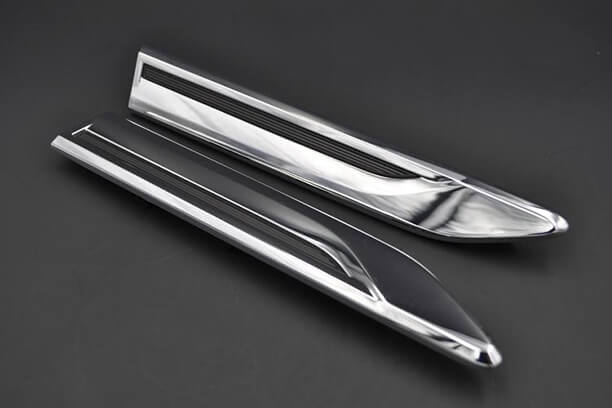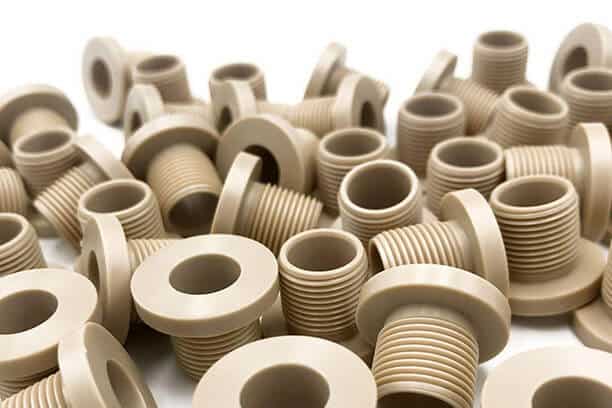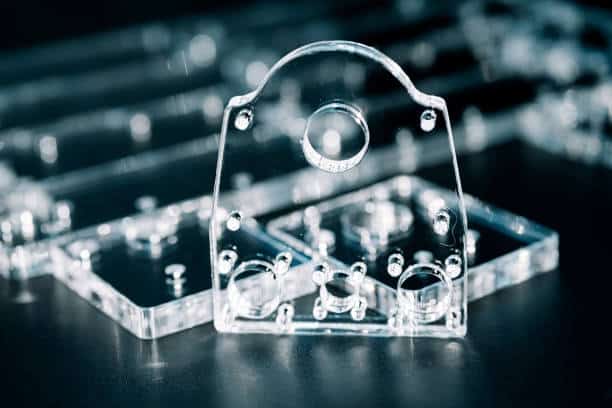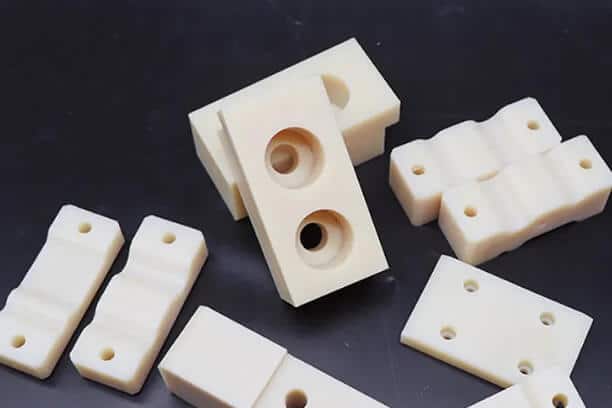Polycarbonate, also referred to as PC, is an amorphous thermoplastic that tends to soften before melting. Its exceptional features, such as clarity, impact resistance, toughness, and lighter weight, make it an ideal alternative to glass. Polycarbonate can withstand higher temperatures than acrylic. Therefore, polycarbonate can be easily machined to produce a multitude of custom parts, especially with the CNC milling technique.
This guide will provide you with an overview of polycarbonate: its primary properties, typical applications, suggestions for machining polycarbonate, and suitable surface finishes available for machined polycarbonate parts.
Overview of Polycarbonate/PC
In the first part, we’ll talk about what’s polycarbonate, its properties, and its different types and grades.
What Is Polycarbonate?
Polycarbonate (PC) is a type of thermoplastic with excellent optical transparency, high toughness and impact strength, and superior creep resistance. It comes with FDA-compliant grades and various compounds that improve its ability to carry loads and resist wear.
Owing to its amorphous composition, relatively low crystallinity, and optical clarity, PC plastic exhibits great transparency to visible light, outperforming many glass variants in terms of light transmission. As a result, polycarbonate is often used as a substitute for glass for applications in automotive lighting systems, shatterproof windows, aerospace industries (such as military fighter jets, and laboratory lenses, electric circuits, etc.) Not only is PC plastic resilient with incredible impact strength even in extreme temperatures, but also it is highly machinable, easy to mold, and thermoform, allowing for precise tolerances with ease.
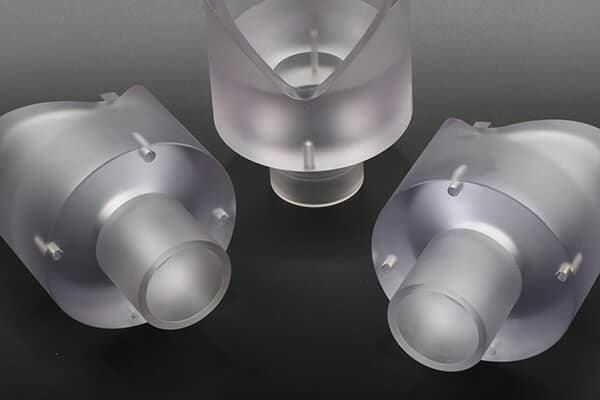
Properties of Polycarbonate
With its exceptional properties, polycarbonate thermoplastic is a commonly preferred option for multiple industrial and commercial applications. More importantly, these qualities are performed to determine the appropriate grades and machinability of the PC, and the suitable machining sequence, then helping to enhance the efficiency of the manufacturing process.
- Optical clarity: Polycarbonate has excellent optical properties due to its amorphous structure. Clear PC is typically used as an alternative to glass with a refractive index of 1.548. It still maintains its transparency while it’s colored.
- High strength and hardness: Polycarbonate is known for its outstanding impact strength and toughness, which enable it to effectively withstand external impact, cracking, and fracturing. It can remain toughness constant at temperatures ranging from -20°C to 140°C. Thus, polycarbonate is ideal for machined parts that require superior reliability and durability.
- High machinability: Polycarbonate is highly machinable due to its heat resistance and durability.
- Transmittance: The typical polycarbonate material can effectively transmit approximately 90% of the light that through it. Such a high level of transmittance allows PC parts well-suited for a broad range of applications, including medical-grade components, prototypes, and decorative goods.
- Lightweight: Polycarbonate is notably lightweight compared to other types of thermoplastics or glass materials.
- Moderate thermal stability: Polycarbonate typically remains stable up to 135°C when subjected to extreme temperatures. In instances where applications require greater thermal resistance, this level can be increased by incorporating flame retardants into the PC. This way effectively improves thermal stability without compromising the chemical properties of the material.
- Dimensional stability: Polycarbonate exhibits high dimensional stability and shrinkage resistance, with a low shrink rate of 0.6%-0.9%.
- FDA-compliance: Polycarbonate is FDA-compliant, so it’s a premier material for medical and food industries to create products.
- UV radiation resistance: Certain polycarbonate grades are specifically designed to block 100% of sunlight, which results in exceptional UV light resistance. This makes PC a desirable choice for medical or packaging products.
- Chemical resistance: Reinforced polycarbonate grades exhibit superior resistance to oils, waxes, aliphatic hydrocarbons, greases, and diluted acids. The ability of chemical resistance makes CNC machined PC parts ideal for industries that require exposure to chemicals.
- Compatibility: Polycarbonate parts can receive coatings such as anti-static, hard coat, and non-glare layers. UV and anti-fog coatings are also accommodated to PC plastic.
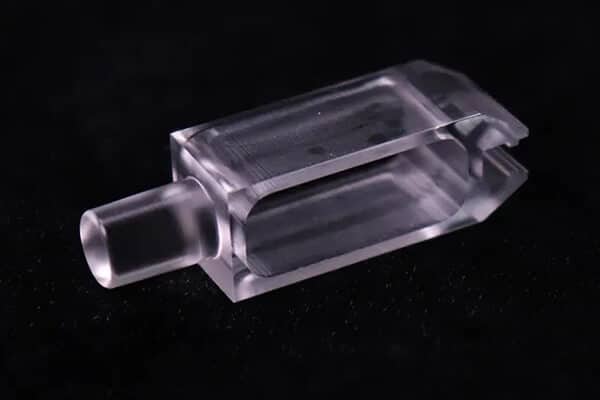
It is worth mentioning that there are some limitations to using the PC as the CNC machining material. Some of these disadvantages include:
- Its susceptibility to dents and high cost.
- It tends to be yellow when subjected to UV radiation for a long time.
- As PC is sensitive to scratching and stress cracking, it may require secondary finishing operations, which is often challenging because only certain techniques like vapor polishing and coating prove effective for PC parts.
- PC parts tend to sink or void in thicker segments. To avoid this, it’s advisable to break up thicker portions into thinner, smaller parts that can be assembled later. Also, given the expenses of the raw materials and machining time, using smaller pieces will likely be more cost-saving than having a thick section machined from a single PC block.
Grades of Polycarbonate
- Glass-filled Polycarbonate: This grade of polycarbonate works well for industrial-grade components. It’s frequently used as a substitute for metals in industrial applications, containing 10-40% glass fibers that enhance the strength of standard polycarbonate. It’s often used as an alternative to metals and engineered plastics due to its high toughness and impact resistance.
- General Purpose Polycarbonate: It’s a grade with comparable transparency to glass and impressively high toughness. Due to its polished surface, this grade is often used for aesthetic purposes. Moreover, it exhibits remarkable resistance to aging when exposed to UV radiation.
- Machine Grade Polycarbonate: It’s a grade that showcases good dimensional stability, impact strength, a high modulus of elasticity, and great electrical properties. Machined parts in this material are well-suited for applications that need significant fabrication efforts.
- TUFFAK® Polycarbonate: It’s an incredibly robust variant of polycarbonate plastic. With twice the strength of glass, TUFFAK® weighs only half as much. It is readily suitable for thermoforming and CNC machining, and it exhibits exceptional compatibility with solvents, paints, and adhesives, as well as high dimensional stability. This plastic grade is further categorized according to compatibility with various industrial applications.
- AMGARDTM Polycarbonate: This is a special polycarbonate grade that incorporates silver ions into the material, which prevents the growth of microorganisms on its surface. This grade is ideal for producing protective shields, medical equipment and devices, and other similar applications that require a surface free from bacteria, mildew, mold, etc.
What Is Polycarbonate Machining and How Does It Work?
Polycarbonate machining is a subtractive machining process involving the removal of extra material from a PC block to create the desired shape and finish. One of the most frequently used methods for this is the CNC machining process.
This process starts by cutting the polycarbonate block into shape through the use of a suitable machining process or multiple processes such as CNC milling, CNC turning, CNC routing, or laser cutting. The choice of a specific process or a combination of these processes is dependent on the manufacturing requirement. After the polycarbonate has been cut to size surface finishing is required to achieve the desired cosmetic finish.
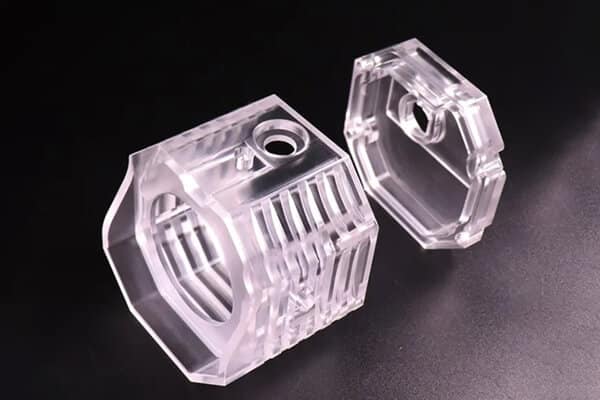
Why Use Polycarbonate for CNC Machining?
Polycarbonate material outperforms various competitive properties compared to other plastic materials.
- It exhibits high load-bearing capacity and superior wear resistance, enabling it to withstand extreme temperatures. Additionally, it is highly machinable, particularly when used for CNC machining operations.
- Polycarbonate is known for its excellent transparency, so it’s ideal for producing see-through components such as eyeglasses, windows, and light covers.
- Polycarbonate is a popular material for electrical insulation applications because It’s biologically inert.
- With its relatively low costs, polycarbonate benefits from being an affordable material suitable for use in various applications across the manufacturing industry.
Tips for CNC Machining PC
CNC milling polycarbonate is a comparatively easy process. The milling technique offers an advantage over sawing as it results in a better edge finish and more precise machining of complex shapes. There are some considerations and tips to enhance the efficiency of the CNC milling polycarbonate process.
1. Use cutters with sharp edges
To ensure a smooth milling process of polycarbonate, it is suggested to confirm that the milling machine has a sharp cutter and an effective chip removal mechanism. Additionally, it is recommended to utilize a vacuum cleaner if the milling machine is equipped with a connection for it.
2. Select correct cutter with proper diameter
For optimum results while milling, choose single-edged carbide (HSS) cutters and ensure to select the appropriate cutter diameter. When working with panels having a thickness of 5 mm and below, it’s recommended to use a 4 mm cutter diameter. For panels that are between 5-10 mm in thickness, select a cutter diameter with a maximum of 6 mm. For panels that are thicker than 10 mm, a cutter diameter between 8-10 mm is most suitable for routing.
3. Place the panel firmly
While milling, ensure to provide support to both the panel and the milling cutter. This can be achieved by placing the panel on a firm surface to avoid machine vibrations. It’s recommended to use a surface that allows the cutter to run, such as a wooden board. Additionally, support the top of the panel effectively so that it stays firmly pressed against the surface. This can be done by using slats and clamps or by utilizing clamps that provide support along the milling line.
4. Set proper feed and speed rates
To achieve optimal machining, begin by utilizing the maximum RPM and feed rates that can achieve accuracy. Then, gradually reduce the feed rates and speeds to attain the best machining results. The plunge rate required may vary depending on the tool types in use, typically ranging from 20 to 120 IPM.
5. Use coolant
During CNC machining, using a coolant lubricant helps to eliminate chips and dissipate heat. There are two specific coolants available when working with polycarbonate material.
The first one is a high-pressure air current which is a simple and fundamental approach that is capable of removing chips and heat effectively. The second method involves the use of pure water, which is capable of delivering superior performance compared to the air current method and is ideal for machining deep grooves.
6. Mill in multiple steps
When working with thicker sheets, it is usually necessary to mill them in multiple steps to achieve a clean edge finish. Milling thin panels up to 5 mm in thickness can be done in a single pass. However, to obtain a cleaner milling edge, it’s important to mill in the opposite direction of the cutter rotation. It’s recommended to mill panels up to 10 mm in thickness in two steps and thicker panel sections in four steps. During the fourth step, run the cutter at a slightly slower speed for an improved edge finish.
Surface Finishing for Machined Polycarbonate
There is a tendency of forming scratches after machining the polycarbonate. Removing scratches from polycarbonate surfaces can be effectively achieved through three polishing processes, namely buffing, vapor polishing, and manual polishing.
Buffing
Buffing is a mechanical method utilizing the power of a rapidly spinning cotton polishing wheel to polish the surfaces. It offers high efficiency, particularly when polishing large parts with simple outer surfaces. One downside, however, is that the buffing process achieves a somewhat less clear polishing effect compared to vapor polishing.
Vapor Polishing
By covering both the exterior and interior surfaces of the part, vapor polishing makes the entire surface evenly polished. This method is designed for polishing polycarbonate components with intricate features.
Manual Polishing
It’s a conventional polishing method depending largely on the experience of the workers and involving virtually no equipment and tooling.
Sandpaper is usually the primary tool employed in this method. Initially, a rough, large grit sandpaper is used for polishing the surface, and eventually, a smaller one is utilized. Although this method generally requires more labor costs compared to the other two ways mentioned above, it is relatively easier to achieve higher gloss surfaces for polycarbonate parts.
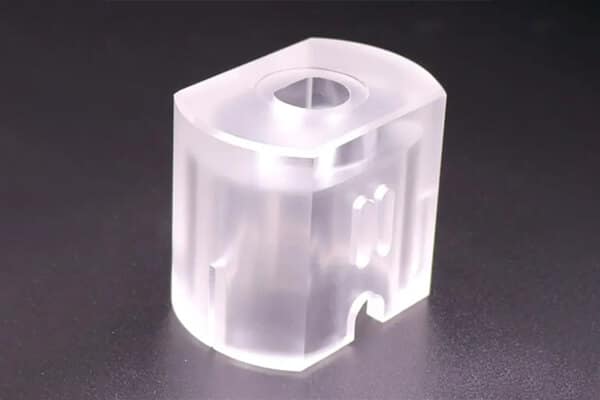
Applications for Polycarbonate Machined Parts
Polycarbonate machined parts are widely found in electronic, automobile, safety equipment, medical equipment, and automotive applications. There are some common parts:
- Seals
- Covers
- Rollers
- Housings
- Manifolds
- Appliances
- Connectors
- Safety helmets
- Car headlight lenses
- Wheels
- Casings
- Gaskets
- Insulators
- Packaging
- Optical storage media
- Machine guards & enclosures
FAQs
Custom CNC Machined PC Parts – Rely On Runsom Precision
Are you looking for a reliable polycarbonate machining supplier? Count on Runsom Precision, and we can deliver top-quality polycarbonate parts based on your specifications. We have state-of-the-art milling machines, lathe machines, and 5-axis CNC machine equipment for plastic machining, enabling us to produce custom polycarbonate prototypes and volume parts within a quick lead time while maintaining tight tolerances and excellent quality for the machined products.
Get started on your project now: simply upload your designs to receive an instant quote for your parts. Alternatively, you can contact us to learn how we can help you bring your project to fruition.
Other Articles You May Be Interested in:

